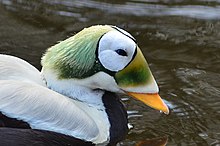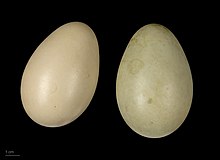Plush head duck
| Plush head duck | ||||||||||||
|---|---|---|---|---|---|---|---|---|---|---|---|---|

Plush head duck ( Somateria fischeri ), a male in front, a female in the back |
||||||||||||
| Systematics | ||||||||||||
|
||||||||||||
| Scientific name | ||||||||||||
| Somateria fischeri | ||||||||||||
| ( Brandt , 1847) |
The plush head duck ( Somateria fischeri ) is a large sea duck that lives on the coasts of Alaska and northeastern Siberia .
description
Plush head ducks are large ducks, but the smallest species within the eider genus . They reach a body length of between 52 and 57 centimeters. The males weigh between 1500 and 1850 grams. The females reach a weight of 1400 to 1850 grams. The species is thus somewhat smaller than the closely related eider .
The males are unmistakable with their black body, white back and yellow-green head, which has two large, white eye-spots. The neck feathers are slightly elongated, which gives this duck a thick-necked appearance. The beak is orange in color and covered by a light green visor with a white border up to the nostrils. The beak nail is light-colored. Legs and feet are light yellow, the webbed feet are gray-yellow. The iris is red-brown.
The female is predominantly brown in color, but can be distinguished from other ducks by her size and shape. It can be easily distinguished from other eider ducks by the clearly visible glasses and the visor over the base of the beak.
voice
So far, no calls have been described for the male. The female gives a guttural croak as an alarm call and calls the chicks with a chuckling buckBUCK-buck-BUCK-buckBUCK . Downy boys emit two-syllable whistles.
distribution
Like few other birds in the Arctic, the plush head duck has a well-defined distribution area. Their breeding area is between the estuaries of the Siberian rivers Kolyma and Indigirka and on both sides of the Yukondelta in Alaska. It occurs on the coast of Northern Siberia from the Bering Strait to the mouth of the Lena River . On the coast of Alaska, the stretch of coast between Point Barrow and the Bristolbay also belongs to its range. They penetrate up to 120 kilometers inland.
Reproduction
Plush head ducks are only available for a very short period of time for their reproduction. The nests are built inland and are usually located near a smaller body of water that is usually the only source of food for a single couple. Several pairs of plush ducks often breed in larger bodies of water.
5 to 9 eggs are laid in the nest, which is built directly on the tundra floor. The eggs are laid every 24 hours. The female usually starts brooding before the clutch is complete. The chicks hatch after 24 days. The young birds fledge after about 50 days.
food
The food, consisting of crustaceans and molluscs , is captured while diving. These birds spend the winter in large flocks on the edge of the pack ice of the Arctic Ocean .
supporting documents
literature
- Janet Kear (Ed.): Ducks, Geese and Swans. Oxford University Press, 2005, ISBN 0-19-854645-9 .
- Hartmut Kolbe; The duck birds in the world. Ulmer Verlag 1999, ISBN 3-8001-7442-1 .
- John Gooders and Trevor Boyer: Ducks of Britain and the Northern Hemisphere. Dragon's World Ltd, Surrey 1986, ISBN 1-85028-022-3 .
- Richard Sale: A Complete Guide to Arctic Wildlife. Christopher Helm Publisher, London 2006, ISBN 0-7136-7039-8 .
Web links
- Somateria fischeri in the endangered Red List species the IUCN 2008. Posted by: BirdLife International, 2008. Accessed January 31 of 2009.
- Videos, photos and sound recordings of Somateria fischeri in the Internet Bird Collection



